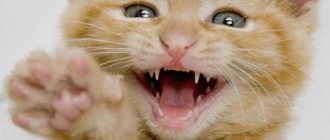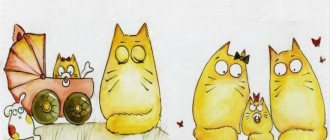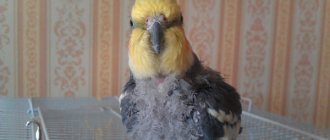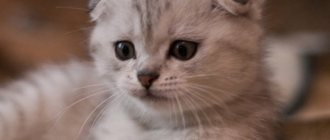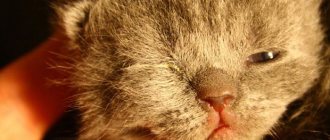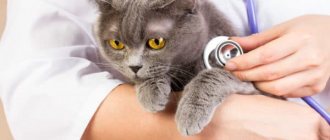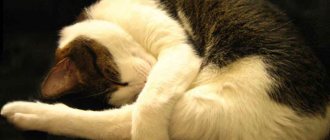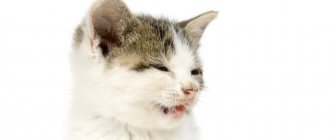Determining age by dental condition
Determining the age of a pet by the condition of its teeth is perhaps the most common way to solve this issue. The teeth of cats of absolutely any breed are identical, for this reason the method of assessing the age of a cat by the general condition of the teeth, as well as their presence, is the most universal.
© shutterstock
The age of kittens is determined by the number of teeth. You just need to know whether the cat’s age corresponds to the period of growth of baby teeth or the period of their replacement by permanent teeth.
Age period of the kitten and tooth growth:
- The period from the second to the fifth week – the incisors appear.
- The period from the third to the eighth week of weeks – fangs appear.
- The period from the fifth to the twelfth week – molars appear.
- From the third to the fifth month - the replacement of milk teeth with permanent ones.
The oral health of adult pets partly depends on their lifestyle and living conditions, as well as their diet. Care and characteristics of cat breeds also play an important role. Some breeders regularly brush their pets' teeth and limit their diet in favor of a healthy diet, which has a positive effect on the condition of the cat's teeth and entire body.
If it is necessary to determine the age of a cat with already formed teeth, a combination of age-related changes in tooth enamel (yellowness, plaque), the condition or presence of incisors, the presence of dental deposits, as well as a number of other signs from the list below are added up.
You can determine the age of a cat by looking at its teeth based on the following signs::
- In one year, all teeth are in good condition, with the exception of damage to the integrity of the tooth due to trauma.
- Starting from one and a half years old, signs of yellowness appear on the enamel.
- Upon reaching two years of age, the middle and central incisors located on the lower jaw are erased.
- Two and a half years are signs of dental plaque.
- At four years old, the middle and central incisors located on the upper jaw begin to wear off.
- By the age of five, signs of wear appear on the fangs.
- At seven years of age, the central and extreme incisors located on the lower jaw wear off.
- From eight to nine years - the central and middle incisors located on the upper jaw, with obvious signs of wear.
- Ten years - the beginning of the period of loss of incisors of the lower jaw
- Twelve years - the beginning of the period of loss of the upper incisors
- From thirteen to fourteen years – absence of all incisors
- From the age of fifteen, a cat loses its fangs and teeth may be completely absent.
© shutterstock
Judging by the above lists regarding age-related changes in a cat’s teeth, it is not difficult to find out how old a pet is. Today, this method is considered the most accurate, but it still needs to be considered in conjunction with other signs of age-related changes in the animal.
Determining the age of kittens
In kittens under 2 months of age, it is difficult to determine their age based on the condition of their teeth, fur and claws. Therefore, the owners observe their behavior and some external signs.
From 0 to 12 days
At this age, the baby is guided by smell. He feeds only on mother's milk and reacts actively to it. If the mother is not around, the babies must be bottle-fed with a special formula for newborns. When there are several kittens, they gather in a “huddle” to keep warm.
INTERESTING TO KNOW: How to understand a cat's language
At this moment of development, the animals have a very awkward physique. The head is large compared to the body and has a wide mouth. The body is weak. At this time, the eyes are closed and the ears are pressed to the head. The defining criterion is the complete absence of teeth in the mouth.
From 12 days to 2 weeks
The kittens are slowly starting to look at the world. They already hear and slowly get up. The babies crawl little by little, helping themselves with their hind legs. Sometimes animals develop strabismus during this period.
Such animals no longer need regular heating with maternal warmth. Their body temperature gradually normalizes. In addition, growth of baby teeth is observed.
2 to 4 weeks
By this time, kittens are gaining weight, it is about 250 grams. Their fangs begin to grow. The eyes are already opening fully, a mischievous sparkle appears. Eye color is still quite difficult to determine.
The animals begin to move and try to jump little by little. At this point, the owner can introduce the first complementary foods. Kittens become playful and pester each other and their mother.
4 to 5 weeks
At this time, the babies are already running briskly and eating food soaked in water. They can be trained to go to the toilet in a specially designated place. The animals develop proper coordination of movements, they no longer stagger when walking as before. At this age, the mother can slowly wean the kittens off milk.
5 to 7 weeks
The eyes take on a color that matches the breed. The bite is formed, as well as the muscles. Kittens play actively: with their mother and surrounding objects. They try the food, use the litter box and explore the apartment in which they live.
During this time interval, the owner should take care of preparing the correct diet for the animal.
2 months or more
The animal acquires traits characteristic of the breed. Kittens can exist without a mother and take food. They exhibit “adult” behavior and can fawn over people.
Cat's age by eyes
The age of a cat can be determined by its look. If for young cats the manifestation of interest and curiosity in their gaze is considered a sign of good health, then for mature cats a calm and attentive gaze becomes the norm.
Just like in humans, in cats, along with other age-related changes, the lens of the eye acquires characteristic features. With return, it fades, which can be explained by the possible development of cataracts. The iris, which also fades with age, also leaves its mark on the cat’s gaze, sometimes spots or patterns appear on it.
Purulent discharge from the eyes is a common problem in older cats. An animal's immunity to infections weakens somewhat with age, so if there is discharge or increased tearing, you should contact a veterinarian. Of course, young cats can also have an eye infection, but older furry pets suffer from this disease much more often.
Estimating the age of a cat based on the condition of its fur
Animal fur has varying degrees of thickness not only depending on the season, but also on the number of years lived. Of course, cats are not susceptible to baldness, but the standing of the hair can say a lot about the lifestyle and age of the pet. Based on the following points, you can draw simple conclusions :
- Young cats have thick fur that is smooth to the touch.
- In older animals, the coat becomes thinner and the fur becomes coarser
- Cats, like humans, may show signs of graying as they age.
© shutterstock
Cat's body condition
Age-related changes affect the entire body. If at the initial stage of life the animal’s body is well developed, which is due to its young age and constant physical activity, then in old age the cat’s body noticeably becomes decrepit.
Assessing a cat's body condition can tell you a lot about the years it has lived.:
- Young cats are muscular and thin
- Middle-aged cats are no longer so active and are usually well-fed, but the muscular corset is still well formed
- Cats with a dozen years behind them can remain well-fed. But their age is revealed by the bones of the shoulder girdle, which begin to protrude greatly. In very old cats, the skin becomes flabby and begins to sag, forming wrinkles and folds.
Why do you need to know how old a cat is?
Indeed, does it matter how old the cat is - 2 years or 5. This opinion is shared by many mustachioed owners. However, you need to know the age of your pet at least in order to understand:
- How to distribute physical activity. There is no need to flirt with an elderly cat until he falls off his feet. Conversely, a young animal may lack activity.
- How to control your health. Caring for young and older pets is different. There are diseases that occur only in old animals.
- How to feed a cat correctly. The body's needs are different at different ages. And if young animals need high-calorie food, then in older animals such nutrition will lead to obesity.
If you are interested in finding out the age of a cat in human terms, read here.
Cat behavior
You can also find out the age of a cat by its activity. The influence of age affects not only the appearance of a pet, but also its habits. Young cats that have just begun their life journey are inquisitive and playful, they are interested in everything new. Middle-aged cats already have life experience; they still show interest in everything new, but they are very cautious and have established habits. Older cats are also not devoid of interest in the world around them, but they can no longer actively move and sleep more often than they are awake.
As cats age, they often begin to show aggression towards strangers; this is associated with increased anxiety and fearfulness. Also, older cats often suffer from a number of chronic diseases, which worsens their well-being, and communicating with a curious stranger does not seem to be the best idea for them against the background of general malaise.
Confirming your guesses with a veterinarian
When purchasing a pet in a specialized nursery or at home, it is very important to find out its date of birth. This information must be displayed in the animal's veterinary passport.
However, the individual found on the street does not have any documents. The future owner, after carefully examining the appearance and observing its behavior, can quite accurately determine how old the animal is.
It would be a good idea to confirm your guesses with a specialist. During the consultation, the veterinarian will confidently give the approximate date of birth. During the examination, the doctor will pay attention to:
- physical parameters;
- emerging teeth;
- ears and eyes;
- genitals;
- wool and color.
Based on the totality of all the signs and a conversation with the owner about the patient’s behavior, the veterinarian will determine the baby’s age. In addition, the doctor will clarify the breed and give recommendations on the selection of diet and care. The doctor will prescribe routine vaccinations and issue a veterinary passport.
Litter box and cat age
If a young cat refuses to use the litter box, then there may be several constructive solutions to this problem, but what if an adult cat begins to refuse to defecate in the place designated for these needs? There may be several reasons for this :
- Stress . Older cats are very sensitive to changes in environment. Even changing the usual filler to another can create discomfort.
- A cat may begin to walk past the area designated for its needs due to problems with vision or smell.
- Kidney and liver disease , inflammation of the genitourinary tract often lead to untimely bowel movements, in which case the cat, in addition to health problems, may begin to experience a feeling of guilt and fear of punishment. It is better not to aggravate the situation and create the most comfortable conditions for the animal.
© shutterstock
Definition of puberty
When a pet comes into a person’s house at an unknown age and it was not possible to calculate it based on its teeth, size and weight, it is enough to wait for the first signs of puberty.
In almost all breeds, females are ready for fertilization by ten to twelve months, and the first heat can occur between six and eight months.
A male can feel the first signs of rutting at about the same age, but some cats remain indifferent to the opposite sex for up to a year or a year and a half.
Both male and female cats can begin to actively mark their territory during puberty.
Typically, purebred kittens reach sexual maturity later than their domestic counterparts.
But the first signs of approaching maturity can be noticed in a pet from four to five months, as hormonal changes in the body begin. This manifests itself in active sniffing of an animal of the opposite sex, and signs of some irritability and aggression appear.
Males can start fighting, dividing territory and females as early as six months. Therefore, you need to behave especially carefully with such teenagers.

